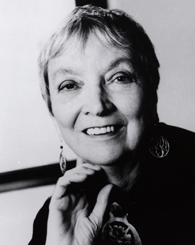Champion of the imagination, devout Christian and feminist, Madeleine L’Engle changed the lives and hearts of many with her books. “A writer of fantasy, fairy tale, or myth must inevitably discover that he is not writing out of his own knowledge or experience, but out of something both deeper and wider,” she explained when accepting her Newbery Medal.
Madeleine L’Engle’s Early Days
“There are really two kinds of girls. Those who read Madeleine L’Engle when they were small, and those who didn’t,” poet Cynthia Zarin recalled that a friend once said to her.
L’Engle grew up like many of her heroines; awkward, unpopular and deeply entrenched in a fictional world. Born on November 29, 1918, Madeleine L’Engle Camp began writing stories at the age of five.
She attended school on the Upper East Side of Manhattan, in New York City, but was not particularly successful as a student. L’Engle attended boarding schools in Switzerland and South Carolina, and was essentially separated from her family for the duration of her adolescence. She went to Smith College and after graduation came back to New York, intending to be an actress.
She wrote at the same time, publishing one novel and finding producers for a number of her own plays. It was while on tour with a production of Anton Chekhov’s “The Cherry Orchard” that she met the man who would become her husband; future “All My Children” soap star Hugh Franklin.
Sources in this Story
- The New Yorker: The Storyteller
- The New York Times: Madeleine L’Engle, Writer of Children’s Classics, Is Dead at 88
- The Washington Post: L’Engle’s ‘Wrinkle’ Smoothed Our Way
- A Wrinkle In Time: 50th Anniversary Commemorative Edition (via Google Books): Newbery Medal Acceptance Speech
- Gifts of Speech: Acceptance Speech Upon Receiving The Margaret Edwards Award by Madeleine L’Engle
- Official website of Madeleine L’Engle
- IMDB.com: A Wrinkle In Time
L’Engle’s Literary Works
L’Engle was a novelist, poet, playwright and essayist, displaying a tremendous range of concepts and philosophies in her work. However, the book she is best known for is probably “A Wrinkle in Time.” Monica Hesse of The Washington Post wrote that for many young girls, “A Wrinkle in Time” was the book that defined them as adolescents, put their awkwardness, intelligence and curiosity in context and taught them the true capacity of imagination.
The book, which has since become an essential member of the young-adult literary canon, was published by Farrar, Straus & Giroux only after 26 other publishers had turned it down. It was incredibly successful, as were the ensuing books in what became a series. The book ended up winning the Newbery Award in 1963.
In L’Engle’s acceptance speech she said that when she was writing the book, she had very little idea of what it was about. She said, “most of what is best in writing isn’t done deliberately.”
Still, much of her writing was autobiographical. She has admitted that she largely based the book’s heroine, Meg Murry, on herself. Her work often reflects her devout religious faith, and she wrote a great deal about all the members of her immediate family.
L’Engle’s other notable series of books began with “Meet the Austins,” which introduced heroine Vicky Austin, whose character is also partially based on L’Engle. The Austin family, beloved by many, was a stylized, idealized representation of L’Engle’s own family. The fourth book in the series, “A Ring of Endless Light,” was also a Newbery Honor Book. But the acclaim that L’Engle received from her public was diminished by her family’s feeling that their lives had been exploited for her writing.
The Woman and Her Work
- “The Wrinkle in Time Quintet Boxed Set”
- “Meet the Austins”
- “A Ring of Endless Light”
- “The Ordering of Love: The New and Collected Poems of Madeleine L’Engle”
- “Walking on Water: Reflections on Faith and Art”
The Rest of the Story
As L’Engle grew older, she wrote autobiographical pieces as well as novels and essays. Her children have said, however, that these autobiographical pieces frequently did not reflect reality.
When L’Engle won the Margaret Edwards Lifetime Achievement Award For Writing in the Field of Young Adult Literature, she said in her acceptance speech, “Truth is what is true, and it’s not necessarily factual. Truth and fact are not the same thing.”
Even as she continued to write and win awards, she worked as a librarian at the Cathedral of St. John the Divine in New York. She died of natural causes on September 6, 2007, at the age of 88.
Her legacy lives on, and her web site has information about events relating to her books. “A Wrinkle In Time” was made into an animated film in 2003; a live-action film is scheduled for release in March 2018.
This article was originally written by Rachel Balik; it was updated November 29, 2017.











